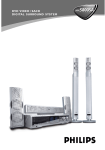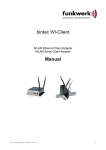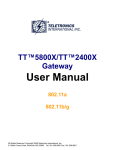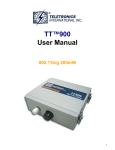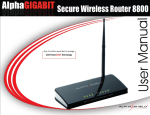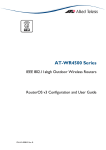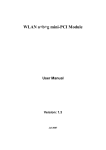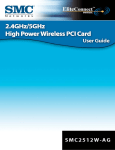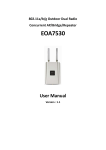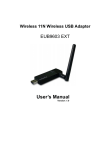Download Shireen Octopus 5800A User manual
Transcript
Octopus 5800 Series User Manual www.shireeninc.com Page | 1 Table of Contents Warranty & RMA Policy Introduction Octopus 5826/5826A Octopus 5800S/5800SA Specs Hardware Specifications Radio Specifications Power Specifications Status Definition Firmware Specifications Package Contents System Requirements Installation Preparing for Installation Windows IP Configuration Settings Web Configuration GUI Firmware Guide & Configurations FAQs & Troubleshooting Guide Glossary Page | 2 Page 3 Page 4 Page 4 Page 5 Page 5 Page 6 Page 6 Page 6 Page 7 Page 7 Page 8 Page 8 Page 10 Page 13 Page 25 Page 26 Warranty Policy All Shireen’s products warranted to the original purchaser to be free from defects in materials and workmanship under normal installation, use, and service for a period of one (1) year from the date of purchase. Under this warranty, Shireen, Inc. shall repair or replace (at its option), during the warranty period, any part that proves be defective in material of workmanship under normal installation, use and service, provided the product is returned Shireen, Inc., or to one of its distributors with transportation charges prepaid. Returned products must include a copy the purchase receipt. In the absence of a purchase receipt, the warranty period shall be one (1) year from the date manufacture. to to of of This warranty shall be voided if the product is damaged as a result of defacement, misuse, abuse, neglect, accident, destruction or alteration of the serial number, improper electrical voltages or currents, repair, alteration or maintenance by any person or party other than a Shireen, Inc. employee or authorized service facility, or any use in violation of instructions furnished by Shireen Inc. This warranty is also rendered invalid if this product is removed from the country in which it was purchased, if it is used in a country in which it is not registered for use, or if it is used in a country for which it was not designed. Due to variations in communications laws, this product may be illegal for use in some countries. Shireen, Inc. assumes no responsibility for damages or penalties incurred resulting from the use of this product in a manner or location other than that for which it is intended. RMA Policy IN NO EVENT SHALL SHIREEN, INC. BE LIABLE FOR ANY SPECIAL, INCIDENTAL OR CONSEQUENTIAL DAMAGES FOR BREACH OF THIS OR ANY OTHER WARRANTY, EXPRESSED OR IMPLIED, WHATSOEVER. Some states do not allow the exclusion or limitation of special, incidental or consequential damages, so the above exclusion or limitation may not apply to you. This warranty gives you specific legal rights, and you may also have other rights that vary from state to state. It is important to us that all Shireen’s products are bought with full confidence. If you are not 100% satisfied with any product purchased from Shireen you may receive a prompt replacement or refund, subject to the terms and conditions outlined below. IMPORTANT: Before returning any item for credit or under warranty repair, you must obtain a Return Merchandise Authorization (RMA) number by filling out the RMA form. Products will not be accepted without an RMA number. 30 Day full refund or credit policy: 1. Product was purchased from Shireen no more than 30 day prior to the return request. 2. All shipping charges associated with returned items are non-refundable. 3. Products are returned in their original condition along with any associated packaging, accessories, mounting hardware and manuals. Any discrepancy could result in a delay or partial forfeiture of your credit. Unfortunately Shireen cannot issue credits for: 1. Products not purchased from Shireen directly. If you purchased from a reseller or distributor you must contact them directly for return instructions. 2. Damaged items as a result of misuse, neglect, or improper environmental conditions. 3. Products purchased direct from Shireen more than 30 days prior to a product return request. To return any product under 1 year warranty for repair/replacement, follow the RMA procedure. Page | 3 Introduction Octopus 5800 Series is an industrial grade outdoor wireless access product available for use as Access point, Bridge or Client for the 5.8 GHz frequency band. With optional amplifier module (Octopus 5826A/Octopus 5800SA), the total EiRP goes up to 54dBm. This unit is the most powerful unit available that can link up to 60 miles (100Km) line of sight. The unit is offered in ruggedized outdoor housing with antenna included and powered over Ethernet. (i) Octopus 5826/5826A The octopus 5826 is the client version of the octopus 5800 Series which includes a fully integrated Panel Antenna. Octopus 5826A is the amplified variant of the octopus 5826 Client with a built in 1 watt amplifier module. Fig 1.1 Octopus 5826/5826A Client (ii) Octopus 5800/5800A The octopus 5800 is the standalone version of the octopus 5800 series with an IP66 standard enclosure. The standalone version is fully customizable with any antenna type and is provided with standard N-Type connectors. The 5800A is the amplified variant of the standalone version. Fig 1.2 Octopus 5800/5800A Page | 4 Specifications • • • • • • • • • • Supports data rates up to 108 Mbps Strong network security with WPA, WPA2 and 64/128 bit WEP encryption. MAC Address Filtering Data based QoS with Stream Engine Technology from Ubicom (Optimal for Media & VOIP Networks) Supports bandwidth and SNMP Management control Provide Window-base Utility, Web, CLI (Command Line Interface) Configuration Adjustable Tx Power settings Configurable ACK timeout for long distance Wireless Distribution System RSSI Led Indicator (i) Hardware *: CPU Memory Embedded OS Network Standard Ethernet Type Network Architecture Status Indication Ubicom ip3023 Network Processing Unit (250MHz) 32 MB SD Ram, 4 MB Flash ipOS from Ubicom IEEE 802.11a, IEEE 802.3 10/100BaseT Ethernet, Auto MDI/MDI-X Infrastructure; Ad-Hoc Power(Red LED), LAN(Green), RF(Green), RSSI(5 Green LEDs) Dimension & Weight (i)5826 With Integrated Antenna (ii)5800S- *Hardware Features are same for both Octopus 5826 and Octopus 5800S (ii) Radio: IEEE 802.11a 5GHz Chipset: Atheros AR5413 Speed (Max): 54Mbps Power Consumption: TX: ~1000mA RX: ~400mA @ 5VDC Output Power (200mw): 23 dBm @ 6-24 Mbps 22 dBm @ 36 Mbps 19 dBm @ 48 Mbps 17 dBm @ 54 Mbps Receiver Sensitivity: -90 dBm @ 6Mbps -70 dBm @ 54Mbps Frequency Range: IEEE 802.11a 5.15~5.35GHz, 5.725~5.850GHz (US & Canada) Page | 5 5.15~5.35GHz, 5.47~5.725GHz (Europe) 4.90~5.00GHz, 5.03~5.091GHz, 5.15~5.25GHz (Japan) Modulation Technique: OFDM and DSSS OFDM: BPSK, QPSK, 16 QAM, 64QAM RF Channels: 12 Non-Overlapping Channels (4 Channels: 5.725 ~ 5.850 GHz) Data Security: 64/128/152 bit WEP, TKIP, AES, IEEE 802.1x Authentication Fully Transparent Bridge: Unlimited MACs (iii) Power Specifications: Input Voltage: 110-240VAC Power Output to Digital Board: 48VDC, 1A (iv) Status Definition: Item State Power RF LAN RSSI Description ON(Red) Off ON(Green) Off Blinking(Green) ON(Green) Off Blinking(Green) Blinking from LED 1 to LED 5 ON Power On No Power Connected No Connection Connected & Transmitting Connected No Connection Connected & Transmitting Searching for AP Connected & Showing Signal Strength Note: the LED Indicators are common to all versions of Octopus 5800 Series (v) Firmware Features: • • • • • • • • • • • • • • • • • • • QoS (Quality of Service) Transmit Power Control WDS (Wireless Distribution System) ACK Timeout Settings CTS/RTS Configuration RSSI (Receiver Signal Strength Indication) Fragmentation Threshold Dual Band Radio Support DFS (Dynamic Frequency Selection) Bandwidth Management Spanning Tree Protocol (802.11d) Support Windows Connect Now Support DHCP Server/Client SNMP Management System Logging DTIM Frame Settings Beacon Settings MAC Based Filtering TFTP Firmware Upgrade Page | 6 • Web Based Firmware Upgrade (vi) Package Contents: • • • • • (vii) Outdoor Unit with Integrated Antenna (1) Mounting Hardware (1) POE Injector (1) 48V DC Power Supply (1) Quick Setup Guide (1) System Requirements: • A PC/Laptop with Ethernet Interface • Ethernet Cable • A Web Browser Preferably Internet Explorer 5.0 + or Mozilla Firefox Page | 7 Installation (i) Hardware Installation: Please follow the following procedure to install the Octopus 5800 ODU. 1. Connect the Data connector of the POE injector to a suitable network PC or switch with a cat5e cable. 2. Connect the ODU connector of the POE injector to the Ethernet connector of the Octopus ODU using a cat5e cable. 3. Power up the POE injector using the provided 48V DC Power Supply. Fig 3. Setting up the ODU 4. Check LEDs on the ODU to confirm status. At this point the PWR LED should be red and Ethernet LED should be green. The RF LED would light up once wireless transmission has started or the device has associated itself to an AP. 5. To access the web manager of the device we need to configure the Windows IP Address Setting so that we are on the same subnet as the device is and are easily able to access the web manager of the device. (ii) Windows IP Configuration: In factory mode the device is not able to assign IP addresses dynamically. You would need to configure your PC to a static address of a subnet range 192.168.0.x to access the web manager and configure the device according to your own liking. Please follow the steps below: 1. Click Start on the taskbar and from the Control Panel choose Network Connections. Right-click the Local Area Connection icon and then choose Properties from the menu. You should see the Local Area Connection Properties dialog box shown below. Page | 8 Fig 4.1 Local Area Connection Properties 2. Set the IP Address of the Windows PC as shown in the figure below: Fig 4.2 IP Properties 3. Power up the device as shown in the hardware installation section. Now you will be able to access the Web Manager/Web Configuration GUI. Page | 9 (iii) Web Configuration GUI: To access the web manager you need to open your web browser and type the ip address corresponding to web manager of each type i.e. client or AP. a) For Octopus 5826 Client the Default IP address of the web manager is 192.168.0.232 b) For Octopus 5800S AP, the Default IP address of the web manager is 192.168.0.231 c) Pressing enter would open the Web Manager/Configuration GUI corresponding to its respective device type as shown in the figure below: Fig 5.1 the AP Bridge Login Screen for the Octopus 5800S AP Page | 10 Fig 5.2 the Client Login Screen for the Octopus 5826Client d) The Login screen is common to both the AP and the client. The default username in factory mode for AP & Client Web Manager/Configuration is Admin and the Password textbox is left empty. e) Pressing the Log In button will take you to the main Control panel of the Web Manager/Configuration GUI as shown in the figures below: Fig 5.3 the Main Control Panel of the Web Manager GUI in Access Point Mode Page | 11 Fig 5.4 the Main Control Panel of the Web Manager GUI in Client Mode Page | 12 Firmware Guide & Configurations This section shows how to configure the firmware of the octopus 5800 Series. Before continuing please do save any configurations changes made to the firmware by the save settings button and reboot the device for the changes to take effect. (i) Basic All the basic LAN & wireless configurations regarding IP Addresses, SSID, Wireless frequency, Channel, Region etc are listed under the Basic Tab. a) LAN • • • • • • By Clicking on the LAN hyperlink you can configure the LAN/Ethernet Settings of the wireless AP according to your own requirement. The Settings are of two types Static and Dynamic (DHCP). These can be changed using the Get LAN IP from drop down box. The IP Address field is used to give the device a static IP address if the IP type is set to Static IP (Manual). In DHCP mode the device automatically allocates an IP using the DHCP spool. The Subnet Mask should be of the same class type as is the IP address. Gateway address is the IP address of the main server from which all traffic is relayed to the access Point i.e. it could be a PC, modem or any other device that is acting as the mainstream for the data. Please refer to the diagrams below for both Static IP and Dynamic IP Settings. Page | 13 b) Wireless The wireless hyperlink under the basic settings tab is used to configure basic wireless settings as shown in the figure below: • • • • • • • The Enable Wireless Radio checkbox can be used to enable/disable the wireless radio. Wireless Network Name field is used to set the SSID of the AP through which the AP is identified at the client end. In factory settings “default” is the SSID. Visibility Status makes the wireless network visible/invisible to clients. This could be used as a security tool to avoid unwanted users to connect to the AP. Auto Channel Select is a feature that chooses the best channel available in terms of interference and signal strength level. It is also known as DFS (Dynamic Frequency Selection). Region & Domain is used to setup the region and domain for this device. This feature is used for areas wherever there is a limitation on channels and transmission power etc. The Channel field is used to choose a specific channel on which the transmission has to take place. The octopus firmware is flexible enough to list all channels for 5.8GHz non-turbo and turbo. Transmission Rate is used to set the bandwidth speed or throughput of the wireless link in mbps. By default its set to Best (automatic). Page | 14 • • • 802.11 mode is the feature that sets the type of 802.11 i.e. a, b or g. This feature is only available where dual band radio is being used and will be missing from independent versions of 5.8GHz firmware and 2.4GHz firmware. The mode for octopus 5800 series is 802.11a. The Super G option enables Super G mode for 802.11g (feature not available in Octopus 5800 Series). Super G is Atheros' proprietary frame-bursting, compression and channel bonding technology to improve IEEE 802.11g wireless LAN performance. The throughput transmission speed limit when using Super G is claimed to be up to 40Mbit/s-60Mbit/s at a 108Mbit/s signaling rate, which is achieved through the bonding of two 54Mbit/s 802.11g channels. Wireless Security Mode will be discussed in detail in the wireless security section. The Octopus 5800S AP supports WEP, WPA-Personal & WPA-Enterprise whereas the Octopus 5826 Client supports only WEP and WPA-Personal. (ii) Advanced The advanced tab gives you access to all advanced wireless settings like Transmit Power Control, MAC filtering, Bandwidth shaping and all other features that make the wireless network perform optimally. a) MAC Address Filter Page | 15 The MAC (Media Access Control) Address filter option is used to control network access based on the MAC Address of the network adapter. A MAC address is a unique ID assigned by the manufacturer of the network adapter. This feature can be configured to ALLOW or DENY network/Internet access. • • • • • • • • The MAC address filter feature is enabled using the Enable MAC Address Filter checkbox. After the checkbox is enabled, all secondary options related to MAC Address Filter are displayed and you will see a view as listed in the diagram above. Filter Settings determine the type of filter that you want to apply. Mode option can be used to set the type of filter i.e. only allow listed machines or deny listed machines Filter Wireless Clients feature can be used to filter clients which are connected wirelessly with the AP on the basis of the MAC address filter Filter Wired Clients feature can be used to filter clients which are connected via Ethernet to the AP. Add MAC Address feature is used to add MAC addresses which you want to filter. To test the functionality you can copy you own PCs MAC address by using the Copy Your PCs MAC Address button. Once you have added the MAC address it is displayed in the MAC Address List where you can view all MAC addresses that are being filtered. You can edit or delete the MAC addresses by using the Edit ( and the Delete ( ) Icons in the MAC Address list. b) Bandwidth Shaping Page | 16 ) The MAC Address Bandwidth Shaping option is used to control bandwidth usage based on the MAC Address of the network adapter. • • • • • • This feature is enabled by checking the Enable Bandwidth Shaping checkbox. The features are expanded into an interface shown in the diagram above. You can add MAC address to which you want to restrict the bandwidth in the MAC Address field and assign a particular name to the computer. Upload rate (Kbits/sec) is given in the Uplink field and Download rate (Kbits/sec) is given in the Downlink field. When you press the save button the particular device to which the bandwidth is restricted is added to the MAC Address List. You can edit or delete the MAC addresses or devices by using the Edit ( Icons in the MAC Address list. Page | 17 ) and the Delete ( ) c) Advanced Wireless Configuration The advance wireless settings are specifically for advanced users who like to tweak their network using these configurations. • • • • • • • • Fragmentation Threshold is a value that determines what should be the frame size or the MTU (Maximum Transmission Unit) size during the wireless transmission. RTS Threshold deals with the sizing of the RTS(Request to Send) Packet which is really essential to start a wireless transmission Beacon Period determines the polling time whenever a beacon is sent between a base station and a client to keep the connection alive and get information about the connection status. DTIM Interval determines the updation of the distributed traffic indication map within the AP. Propagation Distance is responsible for setting the distance as a fixed parameter and to tell the AP that the transmission that is taking place has a propagation of X Kms 802.11d Enable turns the feature of spanning tree protocol (802.11d) which is a wireless network communications specification for use in countries where systems using other standards in the 802.11 family are not allowed to operate. Transmit Power or TPC field is used to set the transmit power of the AP in dBm. The max value that can be set is 30dBm or 1 Watt. WDS Enable turns the Wireless Distribution System on. You can give MAC Addresses of other APs to which this AP would talk to through this option and the whole system would act as a WDS. (iii) Tools Page | 18 a) Admin Page | 19 b) Time Page | 20 c) System d) Firmware Page | 21 (iv) Status a) Device Info Page | 22 b) Wireless c) Logs Page | 23 d) Statistics (v) Help Page | 24 FAQs & Troubleshooting Guide Page | 25 Glossary A Access Control List ACL. This is a database of network devices that are allowed to access resources on the network. Access Point AP. Device that allows wireless clients to connect to it and access the network ActiveX A Microsoft specification for the interaction of software components. Ad-hoc network Peer-to-Peer network between wireless clients Address Resolution Protocol ARP. Used to map MAC addresses to IP addresses so that conversions can be made in both directions. ADSL Asymmetric Digital Subscriber Line Advanced Encryption Standard AES. Government encryption standard Alphanumeric Characters A-Z and 0-9 Antenna Used to transmit and receive RF signals. AppleTalk A set of Local Area Network protocols developed by Apple for their computer systems AppleTalk Address Resolution Protocol AARP. Used to map the MAC addresses of Apple computers to their AppleTalk network addresses, so that conversions can be made in both directions. Application layer 7th Layer of the OSI model. Provides services to applications to ensure that they can communicate properly with other applications on a network. ASCII American Standard Code for Information Interchange. This system of characters is most commonly used for text files Attenuation The loss in strength of digital and analog signals. The loss is greater when the signal is being transmitted over long distances. Authentication To provide credentials, like a Password, in order to verify that the person or device is really who they are claiming to be Automatic Private IP Addressing APIPA. An IP address that that a Windows computer will assign itself when it is configured to obtain an IP address automatically but no DHCP server is available on the network B Backward Compatible The ability for new devices to communicate and interact with older legacy devices to guarantee interoperability Bandwidth The maximum amount of bytes or bits per second that can be transmitted to and from a network device Basic Input/Output System BIOS. A program that the processor of a computer uses to startup the system once it is turned on Baud Data transmission speed Beacon A data frame by which one of the stations in a Wi-Fi network periodically broadcasts network control data to other wireless stations. Bit rate Page | 26 The amount of bits that pass in given amount of time Bit/sec Bits per second BOOTP Bootstrap Protocol. Allows for computers to be booted up and given an IP address with no user intervention Bottleneck A time during processes when something causes the process to slowdown or stop all together Broadband A wide band of frequencies available for transmitting data Broadcast Transmitting data in all directions at once Browser A program that allows you to access resources on the web and provides them to you graphically C Cable modem A device that allows you to connect a computer up to a coaxial cable and receive Internet access from your Cable provider CardBus A newer version of the PC Card or PCMCIA interface. It supports a 32-bit data path, DMA, and consumes less voltage CAT 5 Category 5. Used for 10/100 Mbps or 1Gbps Ethernet connections Client A program or user that requests data from a server Collision When do two devices on the same Ethernet network try and transmit data at the exact same time. Cookie Information that is stored on the hard drive of your computer that holds your preferences to the site that gave your computer the cookie D Data Information that has been translated into binary so that it can be processed or moved to another device Data Encryption Standard Uses a randomly selected 56-bit key that must be known by both the sender and the receiver when information is exchanged Data-Link layer The second layer of the OSI model. Controls the movement of data on the physical link of a network Database Organizes information so that it can be managed updated, as well as easily accessed by users or applications. DB-25 A 25 ping male connector for attaching External modems or RS-232 serial devices DB-9 A 9 pin connector for RS-232 connections dBd Decibels related to dipole antenna dBi Decibels relative to isotropic radiator dBm Decibels relative to one milliwatt Decrypt To unscramble an encrypted message back into plain text Default A predetermined value or setting that is used by a program when no user input has been entered for this value or setting Page | 27 Demilitarized zone DMZ: A single computer or group of computers that can be accessed by both users on the Internet as well as users on the Local Network, but that is not protected by the same security as the Local Network. DHCP Dynamic Host Configuration Protocol: Used to automatically assign IP addresses from a predefined pool of addresses to computers or devices that request them Digital certificate: An electronic method of providing credentials to a server in order to have access to it or a network Direct Sequence Spread Spectrum DSSS: Modulation technique used by 802.11b wireless devices DMZ "Demilitarized Zone". A computer that logically sits in a "no-mans land" between the LAN and the WAN. The DMZ computer trades some of the protection of the Access Point's security mechanisms for the convenience of being directly addressable from the Internet. DNS Domain Name System: Translates Domain Names to IP addresses Domain name A name that is associated with an IP address Download To send a request from one computer to another and have the file transmitted back to the requesting computer DSL Digital Subscriber Line. High bandwidth Internet connection over telephone lines Duplex Sending and Receiving data transmissions at the sane time Dynamic DNS service Dynamic DNS is provided by companies to allow users with Dynamic IP addresses to obtain a Domain Name that will always by linked to their changing IP address. The IP address is updated by either client software running on a computer or by a Access Point that supports Dynamic DNS, whenever the IP address changes Dynamic IP address IP address that is assigned by a DHCP server and that may change. Cable Internet providers usually use this method to assign IP addresses to their customers. E EAP Extensible Authentication Protocol Email Electronic Mail is a computer-stored message that is transmitted over the Internet Encryption Converting data into cyphertext so that it cannot be easily read Ethernet The most widely used technology for Local Area Networks. F Fiber optic A way of sending data through light impulses over glass or plastic wire or fiber File server A computer on a network that stores data so that the other computers on the network can all access it File sharing Allowing data from computers on a network to be accessed by other computers on the network with different levels of access rights Firewall A device that protects resources of the Local Area Network from unauthorized users outside of the local network Firmware Programming that is inserted into a hardware device that tells it how to function Fragmentation Page | 28 Breaking up data into smaller pieces to make it easier to store FTP File Transfer Protocol. Easiest way to transfer files between computers on the Internet Full-duplex Sending and Receiving data at the same time G Gain The amount an amplifier boosts the wireless signal Gateway A device that connects your network to another, like the internet Gbps Gigabits per second Gigabit Ethernet Transmission technology that provides a data rate of 1 billion bits per second GUI Graphical user interface H H.323 A standard that provides consistency of voice and video transmissions and compatibility for videoconferencing devices Half-duplex Data cannot be transmitted and received at the same time Hashing Transforming a string of characters into a shorter string with a predefined length Hexadecimal Characters 0-9 and A-F Hop The action of data packets being transmitted from one Access Point to another Host Computer on a network HTTP Hypertext Transfer Protocol is used to transfer files from HTTP servers (web servers) to HTTP clients (web browsers) HTTPS HTTP over SSL is used to encrypt and decrypt HTTP transmissions Hub A networking device that connects multiple devices together I ICMP Internet Control Message Protocol IEEE Institute of Electrical and Electronics Engineers IGMP Internet Group Management Protocol is used to make sure that computers can report their multicast group membership to adjacent Access Points IIS Internet Information Server is a WEB server and FTP server provided by Microsoft IKE Internet Key Exchange is used to ensure security for VPN connections Infrastructure In terms of a wireless network, this is when wireless clients use an Access Point to gain access to the network Internet Page | 29 A system of worldwide networks which use TCP/IP to allow for resources to be accessed from computers around the world Internet Explorer A World Wide Web browser created and provided by Microsoft Internet Protocol The method of transferring data from one computer to another on the Internet Internet Protocol Security IPsec provides security at the packet processing layer of network communication Internet Service Provider An ISP provides access to the Internet to individuals or companies Intranet A private network Intrusion Detection A type of security that scans a network to detect attacks coming from inside and outside of the network IP Internet Protocol IP address A 32-bit number, when talking about Internet Protocol Version 4, that identifies each computer that transmits data on the Internet or on an Intranet IPsec Internet Protocol Security IPX Internetwork Packet Exchange is a networking protocol developed by Novel to enable their Netware clients and servers to communicate ISP Internet Service Provider J Java A programming language used to create programs and applets for web pages K Kbps Kilobits per second Kbyte Kilobyte L LAN Local Area Network Latency The amount of time that it takes a packet to get from the one point to another on a network. Also referred to as delay LED Light Emitting Diode Legacy Older devices or technology Local Area Network A group of computers in a building that usually access files from a server LPR/LPD "Line Printer Requestor"/"Line Printer Daemon". A TCP/IP protocol for transmitting streams of printer data. L2TP Layer 2 Tunneling Protocol M MAC address Page | 30 A unique hardware ID assigned to every Ethernet adapter by the manufacturer. Mbps Megabits per second MDI Medium Dependent Interface is an Ethernet port for a connection to a straight-through cable MDIX Medium Dependent Interface Crossover, is an Ethernet port for a connection to a crossover cable MIB Management Information Base is a set of objects that can be managed by using SNMP Modem A device that Modulates digital signals from a computer to an analog signal in order to transmit the signal over phone lines. It also Demodulates the analog signals coming from the phone lines to digital signals for your computer MPPE Microsoft Point-to-Point Encryption is used to secure data transmissions over PPTP connections MTU Maximum Transmission Unit is the largest packet that can be transmitted on a packet-based network like the Internet Multicast Sending data from one device to many devices on a network N NAT Network Address Translation allows many private IP addresses to connect to the Internet, or another network, through one IP address NetBEUI NetBIOS Extended User Interface is a Local Area Network communication protocol. This is an updated version of NetBIOS NetBIOS Network Basic Input/Output System Netmask Determines what portion of an IP address designates the Network and which part designates the Host Network Interface Card A card installed in a computer or built onto the motherboard that allows the computer to connect to a network Network Layer The third layer of the OSI model which handles the routing of traffic on a network Network Time Protocol Used to synchronize the time of all the computers in a network NIC Network Interface Card NTP Network Time Protocol O OFDM Orthogonal Frequency-Division Multiplexing is the modulation technique for both 802.11a and 802.11g OSI Open Systems Interconnection is the reference model for how data should travel between two devices on a network OSPF Open Shortest Path First is a routing protocol that is used more than RIP in larger scale networks because only changes to the routing table are sent to all the other Access Points in the network as opposed to sending the entire routing table at a regular interval, which is how RIP functions P Password A sequence of characters that is used to authenticate requests to resources on a network Page | 31 Personal Area Network The interconnection of networking devices within a range of 10 meters Physical layer The first layer of the OSI model. Provides the hardware means of transmitting electrical signals on a data carrier Ping A utility program that verifies that a given Internet address exists and can receive messages. The utility sends a control packet to the given address and waits for a response. PoE Power over Ethernet is the means of transmitting electricity over the unused pairs in a category 5 Ethernet cable POP3 Post Office Protocol 3 is used for receiving email Port A logical channel endpoint in a network. A computer might have only one physical channel (its Ethernet channel) but can have multiple ports (logical channels) each identified by a number. PPP Point-to-Point Protocol is used for two computers to communicate with each over a serial interface, like a phone line PPPoE Point-to-Point Protocol over Ethernet is used to connect multiple computers to a remote server over Ethernet PPTP Point-to-Point Tunneling Protocol is used for creating VPN tunnels over the Internet between two networks Preamble Used to synchronize communication timing between devices on a network Q QoS Quality of Service R RADIUS Remote Authentication Dial-In User Service allows for remote users to dial into a central server and be authenticated in order to access resources on a network Reboot To restart a computer and reload it's operating software or firmware from nonvolatile storage. Rendezvous Apple's version of UPnP, which allows for devices on a network to discover each other and be connected without the need to configure any settings Repeater Retransmits the signal of an Access Point in order to extend it's coverage RIP Routing Information Protocol is used to synchronize the routing table of all the Access Points on a network RJ-11 The most commonly used connection method for telephones RJ-45 The most commonly used connection method for Ethernet RS-232C The interface for serial communication between computers and other related devices RSA Algorithm used for encryption and authentication S Server A computer on a network that provides services and resources to other computers on the network Session key Page | 32 An encryption and decryption key that is generated for every communication session between two computers Session layer The fifth layer of the OSI model which coordinates the connection and communication between applications on both ends Simple Mail Transfer Protocol Used for sending and receiving email Simple Network Management Protocol Governs the management and monitoring of network devices SIP Session Initiation Protocol. A standard protocol for initiating a user session that involves multimedia content, such as voice or chat. SMTP Simple Mail Transfer Protocol SNMP Simple Network Management Protocol SOHO Small Office/Home Office SPI Stateful Packet Inspection SSH Secure Shell is a command line interface that allows for secure connections to remote computers SSID Service Set Identifier is a name for a wireless network Stateful inspection A feature of a firewall that monitors outgoing and incoming traffic to make sure that only valid responses to outgoing requests are allowed to pass though the firewall Subnet mask Determines what portion of an IP address designates the Network and which part designates the Host Syslog System Logger -- a distributed logging interface for collecting in one place the logs from different sources. Originally written for UNIX, it is now available for other operating systems, including Windows. T TCP Transmission Control Protocol TCP/IP Transmission Control Protocol/Internet Protocol TCP Raw A TCP/IP protocol for transmitting streams of printer data. TFTP Trivial File Transfer Protocol is a utility used for transferring files that is simpler to use than FTP but with less features Throughput The amount of data that can be transferred in a given time period Traceroute A utility displays the routes between you computer and specific destination U UDP User Datagram Protocol Unicast Communication between a single sender and receiver Universal Plug and Play A standard that allows network devices to discover each other and configure themselves to be a part of the network Upgrade Page | 33 To install a more recent version of a software or firmware product Upload To send a request from one computer to another and have a file transmitted from the requesting computer to the other UPnP Universal Plug and Play URL Uniform Resource Locator is a unique address for files accessible on the Internet USB Universal Serial Bus UTP Unshielded Twisted Pair V Virtual Private Network VPN: A secure tunnel over the Internet to connect remote offices or users to their company's network VLAN Virtual LAN Voice over IP Sending voice information over the Internet as opposed to the PSTN VoIP Voice over IP W Wake on LAN Allows you to power up a computer though it's Network Interface Card WAN Wide Area Network WCN Windows Connect Now. A Microsoft method for configuring and bootstrapping wireless networking hardware (access points) and wireless clients, including PCs and other devices. WDS Wireless Distribution System. A system that enables the interconnection of access points wirelessly. Web browser A utility that allows you to view content and interact with all of the information on the World Wide Web WEP Wired Equivalent Privacy is security for wireless networks that is supposed to be comparable to that of a wired network Wi-Fi Wireless Fidelity Wi-Fi Protected Access An updated version of security for wireless networks that provides authentication as well as encryption Wide Area Network The larger network that your LAN is connected to, which may be the Internet itself, or a regional or corporate network Wireless ISP A company that provides a broadband Internet connection over a wireless connection Wireless LAN Connecting to a Local Area Network over one of the 802.11 wireless standards WISP Wireless Internet Service Provider WLAN Wireless Local Area Network WPA Wi-Fi Protected Access. A Wi-Fi security enhancement that provides improved data encryption, relative to WEP. Page | 34 X xDSL A generic term for the family of digital subscriber line (DSL) technologies, such as ADSL, HDSL, RADSL, and SDSL. Y Yagi antenna A directional antenna used to concentrate wireless signals on a specific location Z # 1 802.11 A family of specifications for wireless local area networks (WLANs) developed by a working group of the Institute of Electrical and Electronics Engineers (IEEE). Page | 35



































